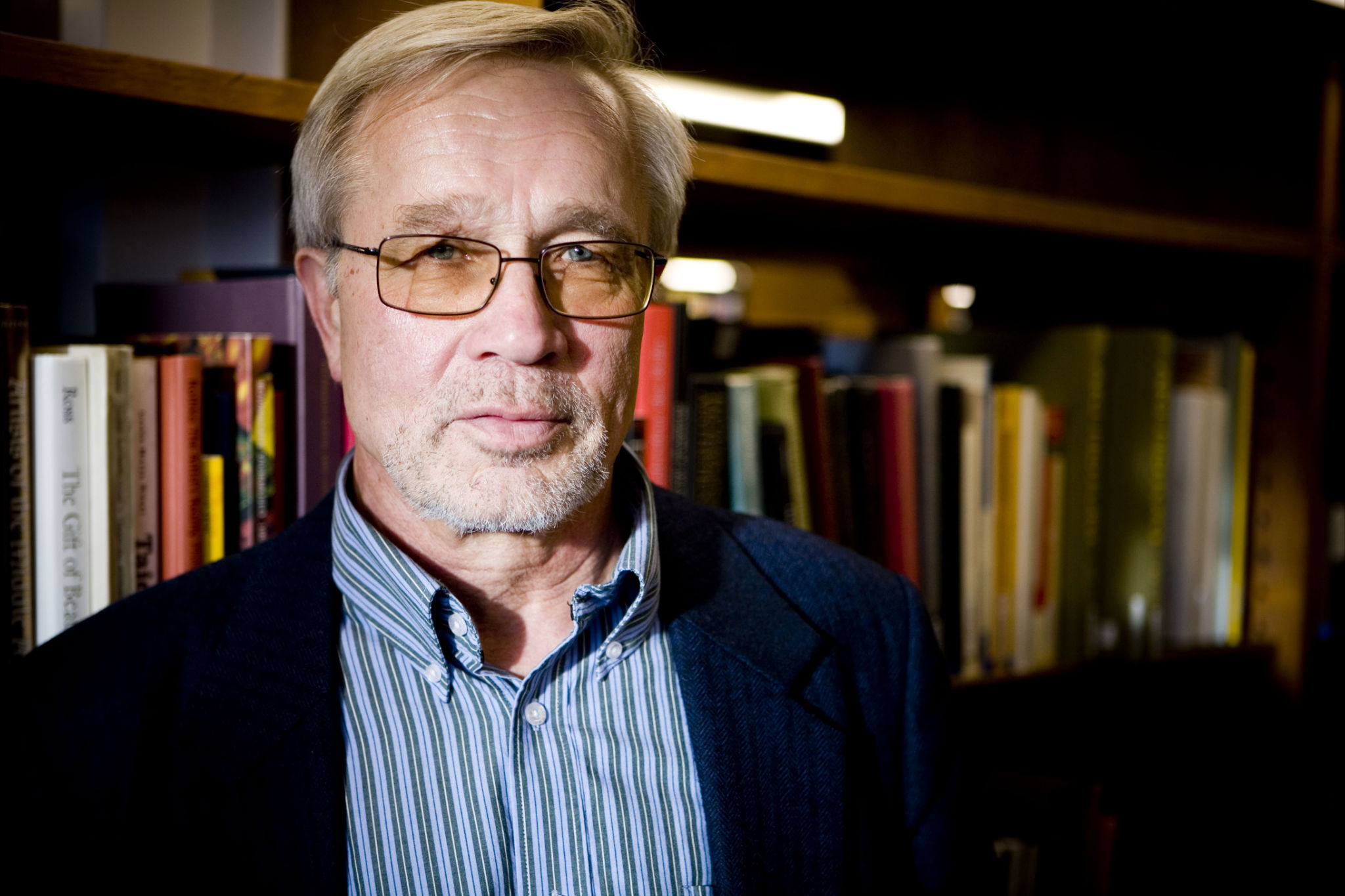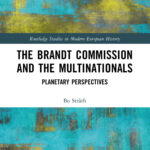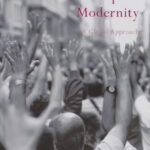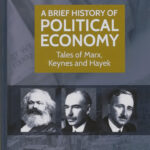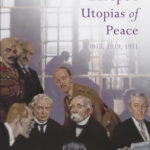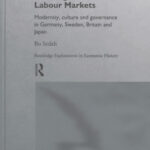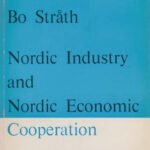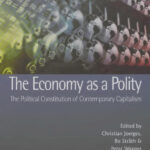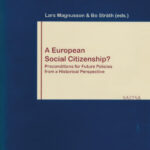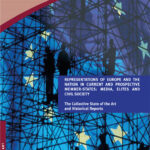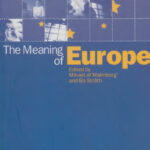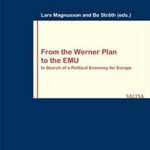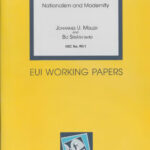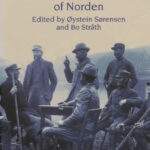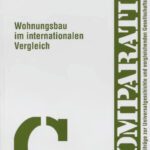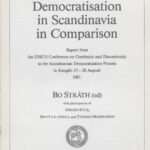Conceptualizing Capitalism: Conversations with Henning Trüper

Conversations with Henning Trüper. Photo Angela Schenk Berlin April 2025.
BS: In 1944, as the end of World War II loomed, Karl Polanyi published The Great Transformation. It was a historical interpretation of how the era of world wars had happened and a proposal about what to do to avoid reiteration. The historical framework dealt with the industrial revolution and the political intervention or renouncement of intervention in that process, and the simultaneous emergence of the market society and the nation state in interactive dynamics. Polanyi thought of this development in more general terms, but his case was Great Britain, and the industrial revolution since the 1830s.
The emerging market society meant attempts of emancipation from social and political ties by economic interests. The representatives of capital and their academic exegetics saw the market as separate from social life, culture, and politics following its own laws and logics. In Polanyi’s view, the industrial revolution didn’t mean an evolutionary self-propelling process but the human-made, politically intended contentious introduction of markets for labor, land, and money. The economy was embedded in politics, social life and culture, although there were arguments that it was autonomous and driven by its own laws and logic. With that argument, continuous attempts to ‘disembed’ it occurred, i e shaking off all ties to politics, social life and culture, claiming that they were subordinate to the economy.
The markets brought the commodification of labor, land, and money. Labor was treated like a commodity to sell and buy, where the power was to set the price. It was not the fiction, the abstraction called market, that automatically set the price despite the fact that labor was seen as a matter of demand and supply. Demand and supply of labor had political, social, and cultural dimensions. The wages were negotiated between humans, representatives of capitalism and labor with varying power relationships. The language of independent “disembedded” markets was an ideology, and those who developed it argued that economic processes were independent of social relations. Polanyi talked about an externalized economy as a capitalist goal.
Economic progress went hand in hand with growing social cleavage and social disintegration. The social unrest and protests against this development forced the states into action. The tension between economic liberalization and social protests and political counter-movements brought economic crises and political upheavals, paving the way to expanding state-building but also towards the two world wars. They were the outcome of the dynamics between disembedding and re-embedding forces when societies, through violence and demagoguery as well as deescalating reforms and compromises, tried to come to terms with the requirements and performance of capitalism.
Polanyi proposed a new kind of re-embedding for the postwar order, not through social protests and political violence but through government planning, regulating and controlling the economy based on binding moral values and duties. His proposal was intended to end the destructive dialectics between disembedding and re-embedding. His proposal was vague but fit rather well with the emerging postwar welfare states in a small part of the world guided by Keynesian redistributive economics in a kind of division of labor between governments and capitalism. The Keynesian approach after the imagined final reembedding was conceived as a lasting arrangement.
Fred Block, the leading specialist on Polanyi, sees him from a reformist perspective, working for an end to fascism but not to history and, in the long run, a transformation to reformist socialism and the subordination of the market to democratic politics. There would still be conflicts and power struggles, and he emphasized that democracy is fragile. The markets constituted a political economy managed by capitalist enterprises and controlled politically.
Keynes would legitimize the postwar arrangement’s interpretative framework when it emerged in the 1950s. Political redistribution through progressive taxes and demand management and the mutually reinforcing dynamics between mass consumption and mass production provided both private profits and public money for welfare. Economic growth was the motor of the system. At the end of the 1960s, few saw an end to the established order and many more perpetuation. Polanyi provided historical legitimization through his outline of what needed to be avoided: the disembedding-embedding dynamics. There is a kind of Hegelian synthesis when the dynamics between mass consumption and mass production replaced the disembedding-reembedding dynamics. The arrangement was valid for a small part of the world but became a goal for much larger parts.
HT: Since you bring up Hegel, I suppose it would also be an interesting question to consider what role a certain kind of historical knowledge, or imaginary knowledge, plays for the market economy. It would seem that the market economy somehow propels itself forward also by way of the conviction that it is itself profoundly modern, that it has broken with the past, that it can always transform itself again, greatly, because it has already done so in the past.
BS: Yes, there is this idea of progress, which is both human-made and propelling automatically. Hegel’s world spirit and Marx’s class struggle, the dialectics towards a better future. However, Polanyi saw the warnings from history instead of progress: economic turmoil from the attempts to create self-regulating markets. He instead expressed progress as hope for the future, not as a prognosis. As Fred Block emphasizes, Polanyi was not a utopian. He believed that humans are imperfect. Hence, he wanted social arrangements to constrain and limit their worst impulses, such as greed.
HT: True, this point is certainly important to keep in mind: no economic reductionism, no sense of an autonomous dynamism of the economic even in its disembedded form, and a certain analytic relevance of moral judgment, to boot. Still, there seems to be an idea of balance guiding this analysis, of stabilizing things and attaining an at least workable and livable system, perhaps a recurrence of the Hegelian Rechtsstaat in a sotto voce register? I always have the impression that the dominant culture of political thought, even on both sides of the iron curtain, in the Cold War period was very bent on finally getting things right.
BS: Yes, subdued, like a subtext of hope, without timpani and trumpets, without overtones and triumphalism. The welfare state would slowly become global, and the Cold War would end. Khrushchev’s idea of peaceful competition. Then came the 1970s crisis. It came suddenly, like a bolt from the blue, although historians since then have invested much energy in explaining that it wasn’t that sudden. It was a poly crisis with several entangled crises. A prominent factor was the collapse of the dollar and the Fordist production regime, which both stood for the reconstruction of the Western world order after the world war. In the wake of that collapse, high inflation, factory closures, and high unemployment followed, which, taken together, raised the specter of the 1930s crisis and the world war that followed.
The experiences of the Great Depression were just one generation old and in fresh memory. The memories were threatful and promoted a different reaction: expansive financial politics against unemployment instead of the austerity approach in the 1930s. However, this reaction, in turn, resulted in an unexpected outcome: high inflation in combination with remaining high unemployment because unemployment was of a different kind now compared to the 1930s. Now it was structural in the wake of the end of Fordism. The high unemployment was not a cyclical phenomenon. Keynes’s interpretative framework lost credibility, which, in turn, paved the way for neoliberal austerity. The austerity approach in the 1930s returned in a situation somewhat later, around 1980, when public opinion had adjusted to the unemployment situation, which seemed less threatening because of the inflation-driving financial packages that stabilized the social consequences of unemployment.
HT: Would you think that the comparison was actually thwarted by the memories of 1929? If so that would be an indication that the 1970s crisis was shaped by different political factors, I suppose?
BS: I am not sure that the memories of the Great Depression counteracted or thwarted the comparison. One particular dimension of the 1930s crisis, the mass unemployment, promoted the comparison as a warning. However, the relevance of the comparison declined rather quickly, because it was not the same kind of unemployment. In the first step, the memories provoked action by the governments to avoid the mistake in the 1930s, when the curse of the gold standard provoked austerity politics. Austerity then meant unemployment. Mass unemployment in the wake of the collapse of the Fordist production regime in the 1970s crisis recalled the memories of the 1930s in what one might call a learning process. The result of the governmental interventions with financial support packages was not, as expected, the return to full employment, however. Instead, it was a new peculiarity called stagflation, a hitherto unknown phenomenon that combines high inflation and unemployment. Unlike in the 1930s, when there were few financial government interventions, the interventions calmed down the unemployment threat to order. In that respect, the governments in the 1970s had learned a lesson from the 1930s crisis. However, inflation became the new key problem, which initiated a new learning process, a revision of the first one. This new learning process brought back austerity and played down unemployment. Another difference was that it was not a speculation bubble that caused the 1970s unemployment crisis. Indeed, as you say, the 1970s crisis was shaped by different political factors. The structural collapse of Fordism made it difficult to find a target for social criticism and protest. The new definition of the problem directed the search for solutions towards austerity.
The beginning of the crisis in the 1970s was seen as the failure of the dollar to maintain its gold commitment, the failure of the dollar to finance the combined Cold War costs and the expenditures for welfare politics, the latter, in turn, a crucial psychological Cold War instrument in the West, and thus closely connected to the military costs. What the pundits in economics and the political and economic elites wanted to prevent in the initial comparison with the 1930s, austerity, came, as I just said, back in through the backdoor in the second estimation of the crisis, moving the focus from the mass unemployment to state finances. There is a historical irony here. Another historical irony is that the corresponding military welfare compact broke down the Soviet empire fifteen years later. Whether capitalism or state socialism didn’t matter. The costs that broke the systems triggered new thinking, and memories of the 1930s lost relevance as the new thinking about the economy and liberalism gained attraction. The overall issue at stake in this reorientation dealt with the redistributive capacity of the states, their tax-collecting capability. The search for solutions in the 1970s went towards outsourcing state commitments to profit-driven private capital providers and austerity with public money. Governmental spending connoted inflation. Prosperous capitalism connoted progress and continued welfare, although in new forms.
Around 1980, an academic-political response to the dollar collapse and the 1970s crisis began to crystallize. It was a political ideology called neoliberal economic theory based on a radical market language where the markets were argued to be self-regulating, politics should abstain from intervention, and governments do nothing beyond monitoring and guarding that the markets were self-regulating. The neoliberal market narrative soon gained credibility in the public debate, and in the 1990s, it became hegemonic.
HT: I had the impression that the ideology was long ready at the time and was just adopted politically, with Thatcher and Reagan both embracing it fully and building their entire political platforms on it.
BS: One might talk about an idea whose time had come. You are right. A liberal rethinking, which in the end became powerful, began in the 1930s on the ruins of the 1929 collapse. In 1938, 26 economists and liberal thinkers met in Switzerland to reflect on the crisis of liberalism. In 1947, a larger group gathered there to form a Transatlantic intellectual community. This was the Mont Pelerin society, named after the meeting place, established to design a new liberalism. One of its leading thinkers was Friedrich Hayek, who, in 1939, published a guiding article. His point was that the market needed state protection to prevent speculation bubbles and other existential disturbances and to ward off social and political pressures against the market mechanisms. Market rule but no laissez-faire. The neoliberal thinking in the wake of Hayek and Mont Pelerin, as it came to be called, did not attract much attention during the Keynesian welfare era but soon entered the stage when austerity again became a theme in response to the 1970s crisis. Hayek’s concern about government control of market rigidity went hand in hand with financial austerity.
What happened on this ground around 1980 looks like a perfect disembedding move in the sense of Polanyi. A historical pattern that Polanyi hoped belonged to the past recurred. Friedrich Hayek and his more laissez-faire orientated colleague Milton Friedman became intellectual reference points. There were also new world leaders impressed by the neoliberal argument, like Ronald Reagan and Margret Thatcher. Soon, other political leaders followed. The representatives of capitalism were less prominent, although they generally, of course, supported the development. Governments disembedded capitalism. They turned Polanyi’s theory on its head. Governments emancipated capitalism by liberalizing financial markets globally. The control of the financial markets was one of the key tools in the governments’ Keynesian implementation of Polanyi’s postwar scenario. Now the governments handed over this key to the representatives of capital. Yes, the governments disembedded capitalism, exposed to the hegemonic market radical discourse as they were. The governments didn’t follow Polanyi’s scheme of disembedding capitalism and reembedding governments.
When I worked on the book about the Brandt Commission, I was puzzled by this development, and I touched upon it in a talk with you, Henning. I don’t remember what the talk was about. Still, I remember your comment on my problem with Polanyi, that the seesaw, the rocker, is a better metaphor for the relationship between politics and capitalism.
HT: I am afraid I cannot reconstruct the exact context of our conversation, either. But I remember referring to Simmel’s Philosophy of Money and the theory of value I think it contains, where money is understood as a process of generalization of the commensurability of values that renders potentially any value commensurate. But because money is a moving frontier it requires incommensurate values on its outside. As a social process, it thus also entails the production of incommensurate values it can then render commensurate. I remember being struck by this principle, which is not actually a form of dialectic in the Hegelian sense, but rather a sort of seesawing movement between the expansion of commensurability and the production of the incommensurate. There is, admittedly, the possibility of an escalation in this movement, of an ever-widening scope, and I did have the impression that Simmel saw modernity, in the context of Philosophy of Money, as having perhaps crossed a certain threshold of escalation. I was also struck by the complete absence of a concept of capitalism in Simmel. It seemed that for him the emergence of money was the true great transformation of value, almost in the form of a historical a priori, and that modernity was then, in a sense, just an escalation of money, not as a system, but as a process.
BS: The emergence of money was the true great transformation of value, you say. This is an important statement. Money made all values potentially commensurable. If all values can be measured in money, there are no absolute values anymore. At the same time, new, at least provisionally absolute values were constantly being recreated. The seesaw board represents this oscillation that both destroys and recreates values? Money would be the hub, the balance point of the swing, which, seemingly immovable, drives the board’s movement up and down, that represents capitalism? All values become relative and changeable. If all values are reduced to a price, aren’t we then close to nihilism? Didn’t Nietzsche think along the same lines as Simmel? Or rather the other way around.
HT: Yes, the other way around. Simmel was later – but he read and wrote on Nietzsche. I do think Nietzsche’s take on value quite strongly influences both Simmel and Weber, although they both would have much rather referenced the academically presentable neo-Kantians on this matter.
BS: According to Simmel, values get a price which can be negotiated on the market. Can values be inflated and deflated depending on the demand-supply relation? Is that what we see when the EU pays billions to Erdogan to keep desperate migrants away? The monetization of human rights.
The marketization of values permeates ever larger segments of society. Marx talked about commodification and there is a connection here, perhaps a radicalization of Marx? You talk about the production of incommensurate values, which are not relative, thus absolute; how should we understand the production of incommensurate values hand in hand with the commensuration of values? Is the incommensuration a consequence? A precondition? Is it the setting up of holy cows to slaughter them? What does an escalation of incommensurate values mean? Can you give some examples?
HT: I do like the image of the holy cows set up for slaughter. I guess from a religious studies perspective, the sacredness of cows in what in modern times came to be called Hinduism is a variant of the eternal postponement of the sacrifice of the sacrificial animal. Sacrifice is an important aspect of any cultural history of value, as it is a paradigmatic form of exchange. Nietzsche draws out this line rather directly, from sacrifice to money to debt to guilt to morality, in the second part of On the Genealogy of Morals. But in the Simmelian perspective, sacrifice is not so much the paradigm of monetary exchange value, but rather the pattern of the incommensurate value that is being rendered commensurate and then exchanged for some other value that is likewise regarded as incommensurate, but only provisionally, for a time. The point is that the question of what is commensurate and incommensurate remains in flow. So yes, there is a proximity to the type of value nihilism one could find in Nietzsche. Then again, this does not mean that there are no values or no validity at all (which is also not Nietzsche’s claim with the Umwertung aller Werte formula, usually translated as “revaluation of all values”). The monetization of human rights is certainly a good type of example (although the relation of rights and values is in itself complicated). In the situation you mention, where the EU pays off its southern neighbors for keeping out migrants, however, the value that is being monetized, in a sense from both sides of the trade (both agree to this), is not so much one to do with the human rights of refugees. Rather, this is a system akin to paying the pizzo, protection money. It is not directly the incommensurate value of human rights that is being monetized here. Rather, this value is simply smothered in favor of the monetization value that is generated from the integrity of borders and border crossings. This integrity, however, is regarded as an incommensurate value connected to statehood: a supposedly good thing the state does, which it does buy for money, but does not, supposedly, sell for money (although states monetize borders through customs and so on, but that is not a matter of security primarily). Protection money functions in the same way, it monetizes what is supposed to be a non-monetary value, the physical integrity of the individual or their property, in ordinary social life. Societies invest quite a bit of effort in the maintenance of such non-monetary values; but monetization is always around the corner. An example not related to criminalized activity is perhaps that of institutionalized humanitarianism, with organizations that operate the same way that corporations do, generating some measure of profit in order to sustain themselves and expand, and at the same time serve a moral value considered as incommensurate. This process then often leads to the disappearance of the original moral value, a certain “cynicism” of practice, as that is often called, a monetization of welfare, and so on. Practitioners often have to make an effort to recuperate, or recreate, the incommensurate moral value of the undertaking. The deeply monetized practice of medicine offers a wealth of examples, too, where the value of healing and saving lives is lost, recuperated, lost again, also shifted ahead to other carriers, or placed in such strange ambiguities as contemporary end-of-life care where the boundary between what is moral and immoral is dreadful to negotiate.
Admittedly, my reconstruction becomes increasingly distant from Simmel; and at least for the sake of conversation, I would not set much store by the exegetic correctness of this account. But I do wonder what work the concept of “capitalism” does for us and whether the description Simmel (or my idiosyncratic reading of Simmel) offers might not help to understand the multiple mutual adaptations of “capital” and “the state” to one another that we have seen over the last decades. And I find it interesting to bring this perspective together with the dynamism of dis- and re-embedding Polanyi posited. I think the Simmelian perspective might help escalating and complicating the dynamism and be more open-ended.
BS: When Simmel talked about money as commensurable values, did he see the monetization of the world as an autonomous process independent of politics, social life and culture?
HT: I would not say so. Rather, he does appear to think that money is what bridges different value spheres. So money in a way is a form of embedding, but to be understood as process rather than as a stable condition, and with a mechanism that produces disembeddings only to be able to sustain itself as a process. Hence the seesawing movement mentioned earlier. In the period around 1900, theoretical discussion amply acknowledges the presence of different “spheres” of social and cultural practice and discourse. The problem, then, is how the spheres interact. Weber thought the spheres were related to social posits of different kinds of value (the arts, for instance, being different from religion, economics, politics and so on). Simmel’s point was, in a way, about the dynamic that money imposes on this order of value spheres, and about challenging the idea of clear and stable separations. Money would appear to run through all the spheres, precisely because they require the work of temporarily exempting values from commensurability; so without money, there would not be even the relative separation of spheres that the sociologists of the time sought to describe. Money was bound eventually to upset any stability, but it would also recreate novel separations, constantly. And the relationship between politics and the monetary economy might be somehow privileged, though one would have to understand better how this would be the case. Perhaps one way ahead would be to think about money not as a metonymy of “the economy” but rather as a separate matter, related and crucial to the nature of value in general, which cannot be reduced to economic value in the sense of the satisfaction of material needs. I think that’s Simmel’s point in philosophizing about money specifically, and not “the economy” – and of course, there is also a longer tradition of philosophical texts that did so, both in Simmel’s past and his future.
BS: Embedding produces disembedding only to be able to sustain itself as a process. I like that way of phrasing the issue. The commensurable produces the incommensurable only to maintain itself as a process where the road becomes the goal. As you said, monetized embedding bridges various social, political, cultural, and economic dimensions of society. There is a generation or two after Simmel, a convincing social anthropological perspective which sees the economy as embedded in society and its culture and social practices. I think of Marcel Mauss, the French sociologist who, in the 1920s, saw the exchange, the key dimension of both barter and capitalist market economy, as a symbolic system where economic relations were social relations. Yes, values were relational but very different from monetized nihilism but perhaps closer to the dynamics of the commensurable making and unmaking the incommensurable. Later, David Graeber followed up with his anthropological value theory. His book on that theme had the subtitle The False Coin of Our Own Dreams. He wrote on debt in that spirit.
HT: Yes, these are all useful references to pursue. I do think the general point that returning to the discussion of value, both theoretically and empirically, might still be worth emphasizing, though: it seems quite absent even in the broad reception Graeber has otherwise, and fortunately, enjoyed. The silence on value has consequences, I think. It has seemed to me for a while that there is a strange separation between theories of capitalism and theories of the political, or even just of the state. Partly, this separation is probably the outcome of a tacit convergence of both liberal and critical understandings of the economy. They appear to meet, although they do not often admit it, in the position that in Marxism is called materialism, so that economic exchanges are something like the base, and politics and ideologies and everything else that societies “construct” are functions of the economic relations at hand. Polanyi might perhaps be seen as providing a historical account of the emergence of this order of things. Disembedding originally is what liberates the modern, capitalist economy to achieve this kind of dominance.
BS: And, according to Polanyi, in the end, it also paved for the big bang world crisis in the 1930s.
HT: Now, if one looks, for instance, at the history of statehood in the same period of the original disembedding, roughly since the eighteenth century, one sees an almost just linear increase of institutional complexity, a constant growth of the text of law, and an expanding set of what one might call technologies of controlling populations. In both the domains of law and technologies of control, there is also a pattern of trial and error, or perhaps of a rough-and-ready expediency, where things are quickly abandoned if they lose their immediate purpose. So, on one hand, there would appear to be institutional learning processes, and on the other, a sort of improvization that goes along with a tendency to quickly forget. Part of this is the problem of institutional memory, which functions rather differently from personal memory, in that it only exists inscribed in routines. The routines are evolving, through conscious, agential decisions; that is the learning part. But when something changes about the routines, memory fades very quickly. Ironically, even in today’s seemingly completely alienated bureaucracies, the fading memory might depend on as little as an exchange of the people upholding the routine. We see this in academic institutions all the time, the kind of loss of know-how that goes along with, say, the loss of a secretary. I do think the same is true, if on a much bigger level, for government, which in all systems is still given to crises of transition from one set of people to another.
I wonder what the welfare state’s history actually looks like from this perspective and what the overall relation between the capitalist economy and the state looks like if one takes the state more seriously.
BS: Your outline shows no economic determinism, on which Polanyi agreed, too. I think that focusing on learning processes providing continuously revised institutional memories, even with scope for forgetting, disruption and new memory constructions, supplements Polanyi’s swing metaphor. The learning process teaches about interactive social, political, and economic dynamics that deny ideas of economic determinism. What you say about institutional forgetting is relevant. It looks like a whole generation of political leaders during a generation of neoliberal hegemony have unlearnt to make interest and ideology-driven politics beyond technocratic administration. The neoliberal mantra that politics must be market-compliant and lack alternatives has, in a Freudian sense, repressed ideas that politics and policies are human-made and begins with a vision of the future based on interests and ideologies. Habitus, credo, an ethos of a generation of political democratic leadership, has changed fundamentally under the imperative of market autonomy.
HT: Yes, and what seems, on the surface, to be something of a moral and intellectual, and even psychological, crisis of the political is, on a deeper level, an interesting form of work that is being invested in the separation of the spheres. Separation, of course, does not have to occur as co-ordination; it can also take the form of subordination, of establishing a hierarchy. The political attitude you describe seems to be an example of willful subordination, of submission on the part of the politicians. But then, there is an underside to this, as the submitting side also claims a position of agency to which the other side does not have access. The economy is actually conceived of as weaker since it is not capable of submitting itself in the same way to the political. So there is a strange exchange of power through submission. Another Hegelian motif perhaps, the famous master-slave trope; but then, shifting discussion into that direction would probably mean to over-emphasize the dualism, and to overlook the point that there is simply a lot of work being invested in establishing the separation of spheres.
BS: One crucial question is how old the separation and the economic predominance are. And what does the separation between politics and economics mean? Polanyi certainly saw economics and politics as two different approaches, but his point was that they were deeply entangled. They constituted each other, and they developed a tension-filled history about being the leading force. What you said about the long-term development of the state shows that politics was not automatically the weaker force. Yes, Marx argued that the economy was the base, and he got many adherents, but ultimately, his prognosis was wrong. Marx did not focus on the market as a separate entity but on social relations in the (labor) market and the working process. Commodification was one of his key concepts. His focus was furthermore on the state as the institutional embodiment/enforcer of capitalism to confront by the unified working class.
It was clear to Polanyi that there was an economic sphere and a political sphere, each with its own specific power structure, which changed over time. For Polanyi, it was clear that politics, the state was the stabilizing and correcting force and his proposal for a stable and peaceful world order after 1945 was a political economy. Yes, the industrial revolution was maybe the backdrop, the prime mover, the basis of the development of modernity, but his industrial revolution was much more than pure economy. It cannot be separated from the enlightenment philosophy, which was much more active than a passive superstructure. What you say about trial and error and learning processes fits very well here, because they tied together politics and economics. State building was also the development of national capitalism hand in hand with the representatives of the state, not only for peaceful social relations as we know, but also for imperialism and warfare. In this state building, Manchester liberals had as little chance as the utopian socialists, as Marx called them. It was a struggle between the state as the protector of private property, the Rechtsstaat, and the state as the protector of the socially weak, the Sozialstaat. There was a dimension of both in various proportions shifting over time in all states. The state was not an abstraction but an institution and normative order that could be changed and was continuously transformed when various interests struggled about the leadership of this creation.
I think the 1930s world economic crisis was the beginning of a deeper split-up, although ideas of economic autonomy existed earlier as you said. When leading liberal thinkers met in the 1930s to discuss the collapse of the liberal world order, some tried to revive Mill and Smith, but the revision went in a different direction which later got the name of neoliberalism. Hayek was one of the protagonists in this rethinking of liberalism. The crisis demonstrated to him that the market economy needed rules that guaranteed cost-reducing competition. This guarantee was the task of the state, but governments should not intervene against the cost-reducing social race to the bottom. Hayek’s solution was to create an iron state to protect market freedom. He wanted to shape the state that Marx wished to destroy. Hayek’s materialism was Marx’s upside-down, but Hayek’s materialism was much more economically reductionist than Marx’s, whose focus was on social relations. Marx’s idea of the workers of the world on the march towards the world revolution soon became the reformist struggle for social improvement in national frameworks, giving the state a social dimension underpinning the continuous transformation just mentioned.
HT: Returning to the question about what to make of the history of the modern welfare state in relation to the seesawing/escalation movement I suggested, it seems to me that the welfare state keeps evolving and crumbling at the same time, growing as an enterprise ever more driven by private capital and crumbling as a public political commitment. and that might have to do with these bewildering institutional structures of evolving forwards and backwards, simultaneously, as one might say.
BS: Yes, forwards and simultaneously backwards, upwards and simultaneously downwards. The board of the seesaw has two ends. To sum up our conversation: There is no capitalism, market, economy, or whatever you call it, operating as an autonomous and self-propelling entity but political, cultural, social, and economic dimensions and entanglements in human societies and communities driven by human action. The dimensions/the entanglements are in continuous tension/détente, conflict/compromise/cooperation. The idea of capitalism or the economy as an autonomous and self-propelling entity with its own specific laws and logic is ideology. It is powerful. The most recent case, the neoliberal globalization narrative, was hegemonic for three decades. However, that doesn’t make the claim for autonomy and superiority more accurate.
We have used Polanyi and Simmel as useful heuristic tools in this discussion. Simmel’s take on money around the relationships between money and value makes Polanyi’s dialectics more contingent and open. The decisive issue at stake becomes the process of monetization, the commensuralization of what is incommensurable, and the continued recreation of new absolute values. Capitalism is not a closed economic system but part of an open political-economic process of continuous transformation.
How to quote:
Cit. Bo Stråth, “Conceptualizing Capitalism: Conversations with Henning Trüper. Blog 1. The Embedding and the Seesaw” Blog. https://www.bostrath.com/planetary-perspectives/conceptualizing-capitalism/blog-1-the-embedding-and-the-seesaw/ Published 29.05.2025
Comments
Please submit your comments with the Contact Form or send an Email to bo.strath@gmail.com.
